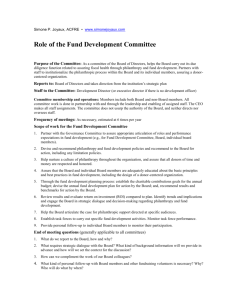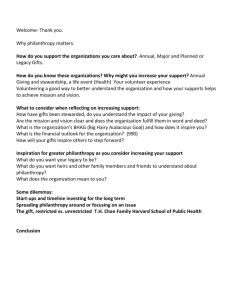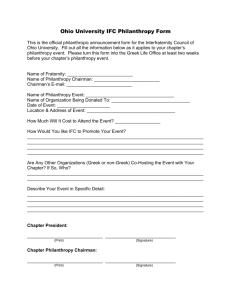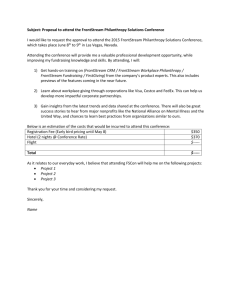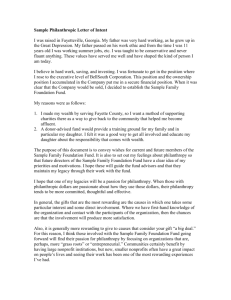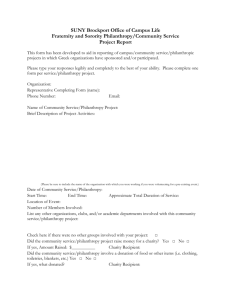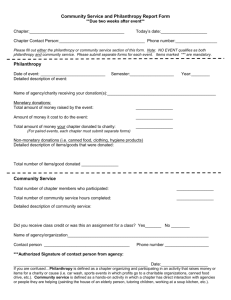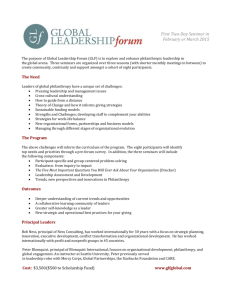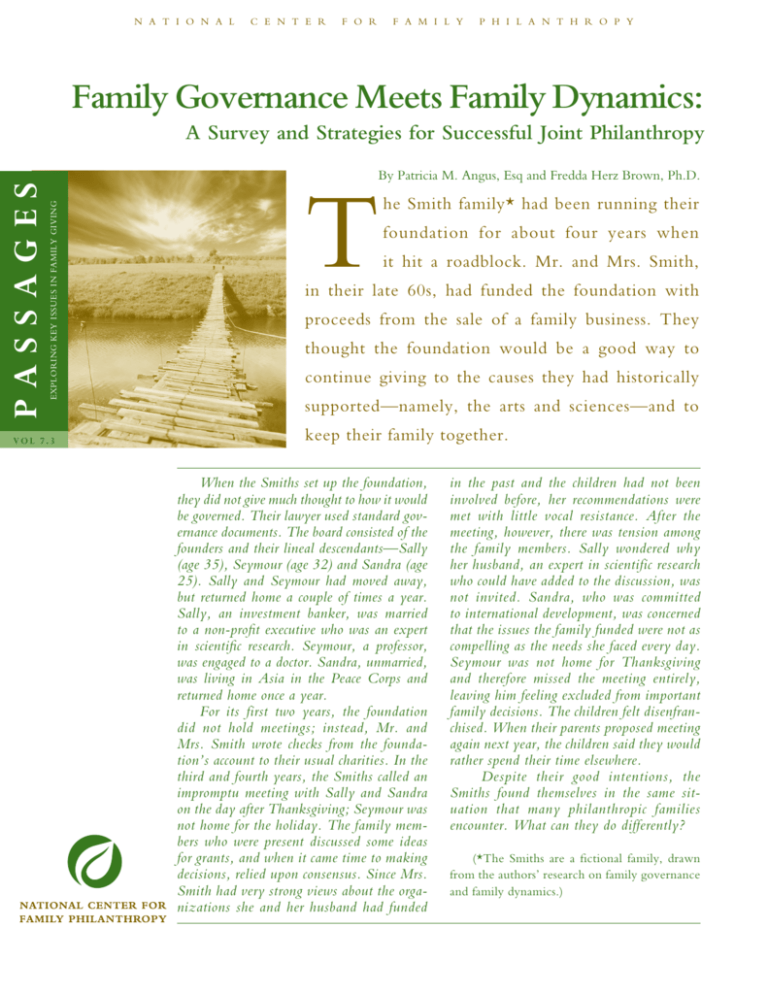
N A T I O N A L
C E N T E R
F O R
F A M I L Y
P H I L A N T H R O P Y
Family Governance Meets Family Dynamics:
By Patricia M. Angus, Esq and Fredda Herz Brown, Ph.D.
Exploring Key Issues in Family Giving
PASSAGES
A Survey and Strategies for Successful Joint Philanthropy
VOL 7.3
T
he Smith family* had been running their
foundation for about four years when
it hit a roadblock. Mr. and Mrs. Smith,
in their late 60s, had funded the foundation with
proceeds from the sale of a family business. They
thought the foundation would be a good way to
continue giving to the causes they had historically
supported—namely, the arts and sciences—and to
keep their family together.
When the Smiths set up the foundation,
they did not give much thought to how it would
be governed. Their lawyer used standard governance documents. The board consisted of the
founders and their lineal descendants—Sally
(age 35), Seymour (age 32) and Sandra (age
25). Sally and Seymour had moved away,
but returned home a couple of times a year.
Sally, an investment banker, was married
to a non-profit executive who was an expert
in scientific research. Seymour, a professor,
was engaged to a doctor. Sandra, unmarried,
was living in Asia in the Peace Corps and
returned home once a year.
For its first two years, the foundation
did not hold meetings; instead, Mr. and
Mrs. Smith wrote checks from the foundation’s account to their usual charities. In the
third and fourth years, the Smiths called an
impromptu meeting with Sally and Sandra
on the day after Thanksgiving; Seymour was
not home for the holiday. The family members who were present discussed some ideas
for grants, and when it came time to making
decisions, relied upon consensus. Since Mrs.
Smith had very strong views about the organizations she and her husband had funded
in the past and the children had not been
involved before, her recommendations were
met with little vocal resistance. After the
meeting, however, there was tension among
the family members. Sally wondered why
her husband, an expert in scientific research
who could have added to the discussion, was
not invited. Sandra, who was committed
to international development, was concerned
that the issues the family funded were not as
compelling as the needs she faced every day.
Seymour was not home for Thanksgiving
and therefore missed the meeting entirely,
leaving him feeling excluded from important
family decisions. The children felt disenfranchised. When their parents proposed meeting
again next year, the children said they would
rather spend their time elsewhere.
Despite their good intentions, the
Smiths found themselves in the same situation that many philanthropic families
encounter. What can they do differently?
(*The Smiths are a fictional family, drawn
from the authors’ research on family governance
and family dynamics.)
passa g es N A T I O N A L
C E N T E R
F O R
INTRODUCTION
Private philanthropy is increasingly a family
affair, with unique opportunities and challenges.
While many families enjoy working together and
are making a positive difference through their philanthropy, other families struggle with two areas
that can be especially troubling: family dynamics and
family governance.
Family dynamics are the ways family members
interact with each other individually and as a distinct system. Often, family members transfer these
ways of interacting to their philanthropic experiences when they work together.
Family governance is the framework in which a
family manages its joint affairs. A family applies guiding principles to general policies and specific practices
for carrying out the roles and responsibilities of their
joint activities, such as family philanthropy.
To learn more about the ways family dynamics
and family governance affect family philanthropy,
we partnered with the National Center for Family
Philanthropy to undertake the most extensive survey to-date on these issues. We chose the National
Center as our partner because its constituency
was broadly representative of family philanthropy
and because its leaders were interested in supporting knowledge development in the field. In our
experience, dynamics, especially when families are
unaware of them, can make philanthropic interactions more difficult, especially in families without
clearly articulated family governance systems. We
hoped to discover how family dynamics were
understood by philanthropic family members and to
explore whether applying solid family governance
could help manage and counterbalance them.
The survey revealed that families with some
awareness of their own family dynamics and that
take charge of their family governance processes are
more likely to have effective and enjoyable philanthropic experiences. Conversely, families who have
not yet examined their interpersonal family dynamics or have treated family governance informally (or
both), face greater struggles. In fact, “When unresolved family ‘stuff’ is too intense,” one respondent
said, “it spills over into family business and family
philanthropy meetings. Often though, [unresolved
family stuff] never is fully identified as such, rather
it’s named as something else.” Other respondents
echoed the sentiment, saying they thought they
F A M I L Y
P H I L A N T H R O P Y
could deal with their philanthropy as a family but
instead found that it was family that became the
problem.
Nearly 90 families responded to our online survey, and several provided input in person or by
telephone. All respondents were engaged in joint
philanthropy, whether informally or through private foundations and donor-advised funds. Asset
bases ranged from $1 million to more than $200
million. Our survey included families just starting
joint philanthropies as well as mature organizations
with more than 50 years of experience.
We hope this paper helps families engaging in
philanthropy together by, first providing an overview of family dynamics and family governance
to aid in identifying some of the key issues, and
second, suggesting solutions to encourage more
effective family philanthropy. Our findings may
be especially helpful to families who are starting
(or thinking about starting) a joint family philanthropy. The findings may also encourage families
currently engaged in joint philanthropy to review
their practices and, if appropriate, make changes
to enhance their effectiveness.
A final note: Our survey would not have been
possible without our respondents’ candor in sharing
the opportunities and challenges of family philanthropy. To protect their privacy, we have not used
their names or the names of their foundations. See page
9 for a description of the survey methodology.
The survey revealed that families
with some awareness of their own
family dynamics and that take
charge of their family governance
processes are more likely to
have effective and enjoyable
philanthropic experiences.
Conversely, families who have not
yet examined their interpersonal
family dynamics or have treated
family governance informally (or
both), face greater struggles.
passa g es N A T I O N A L
C E N T E R
F O R
F A M I L Y
P H I L A N T H R O P Y
FAMILY DYNAMICS
Family dynamics in the Smith family have not
changed for decades. Mr. and Mrs. Smith have an especially close relationship, built through years of working
side-by-side. While they were building their business,
they did not have much time for their two oldest children. But the youngest, Sandra, had the advantage of
a close relationship with her parents. Still, she often felt
cut off from the bond between Sally and Seymour, her
two older siblings who were closer in age.
Because the family had not had much opportunity
to communicate about and make decisions as a group
in the past, they tended to defer their grantmaking
decisions to Mrs. Smith, who was quite articulate and
had a take-charge approach to family matters. During
the first two years the foundation existed, the children
had no voice; the parents made grant decisions without
their input. But at their first group meeting the day
after Thanksgiving, the two siblings who were present
felt overwhelmed by the new challenge of being on the
board and learning the grantmaking craft. Although
they were highly competent adults, they reverted back
to their childhood roles. They felt they needed to honor
their parents’ wishes because it had been “their” business sale that started the foundation, despite the fact
that the children were substantial owners of proceeds
from the sale and were foundation board members.
None of the family members had considered how they
related as separate individuals or as a connected group.
Family dynamics comprise the sum total of
a family’s ways of interacting with each other.
Gender, sibling relationships, and the number of
members, to name a few variables, affect family
interactions. The family dynamics stemming from
these variables are patterned over time and tend
to repeat themselves in predictable ways. Firm
alliances and distances appear between family
members, especially when they share assets. In
one family, the youngest of three siblings often
felt like she was still playing her role in growing
up—the one who ultimately made decisions
based on the input of the family member with
whom she was allied for each particular issue.
Her older siblings, a brother and a sister, spent
their time before meetings trying to enlist her
support. In another situation, first-generation
family foundation members excluded their
offspring; an exclusion that continued into the
…entrenched familial
patterns around power,
control, leadership, authority
and decision-making are
important to understanding
a family’s dynamics and how
they relate to governance.
third generation and led to conflict that put the
foundation’s operations at risk. Such entrenched familial patterns around power,
control, leadership, authority and decision-making are
important to understanding a family’s dynamics and
how they relate to governance. Acknowledging these
interactive patterns may suggest the kinds of formal
family governance policies and practices needed to
assure that all family members know and fulfill their
roles in the family philanthropy. Family governance
policies may also be used to counterbalance natural
alliances that the family deems unproductive.
Another area that affects family dynamics is the
desire for individual members to be connected to the
family while at the same time desiring independence.
“Our family believes that we all must do everything
as one big happy unit,” said one survey respondent,
but “that always seems to lead to the opposite. There
are lots of reasons for us to do things individually,
including some of our divergent interests.”
At the other end of the spectrum are family foundations where members distribute funds
separately, with few or no connections that make
their interactions a family foundation. Several
respondents noted that when they began their
joint efforts, most of the work was individually
based because they were unable to define a joint
mission and vision for their giving. “Without
some mechanism for individual giving,” said
one respondent from a large multi-generational
foundation, “getting agreement on the collective giving seemed impossible.” Creating family
governance policies that reflect the dual desire for
individual and joint grantmaking can help family
members feel satisfied overall.
passa g es N A T I O N A L
C E N T E R
F O R
FAMILY DYNAMICS—BASIC CONCEPTS
The following concepts are critical to understanding
how families function together. They may help shed
light on some of the family dynamics that could be
at work in family philanthropy.
FAMILY AS A SYSTEM: Individual behavior
is really part of the whole—to understand any one
person, his/her behavior must be viewed in the context of the family system, the way in which he/she
interacts with others. Families have a way of moving
together and acting together, with each person having
his/her part in the play.
TRIANGLES: The basic building blocks of human
relationships. Triangles focus on how people are
joined together and disconnected. When interaction
between any two people is dependent upon where
they are with regard to a third, a triangle is established. Relationships in which each person has direct
interaction with the others are the best practice but
hard to achieve when one family member does not
want to have conflict or hurt someone else.
BIRTH ORDER: Provides a basic framework
for understanding how an individual tends to
behave when in a group of peers. When those
peers are siblings, family dynamics come into
play. In addition, the gender of siblings is significant to understanding how birth order impacts
behavior. If a family member is an oldest daughter of daughters, her way of dealing with younger
men and women peers will be different than an
older brother of sisters. The position itself defines
certain themes—an oldest sister might tend to be
directive while a youngest might be more subtle
in leading.
SEPARATENESS/CONNECTEDNESS:
Throughout their life cycles, families go through
a process of expanding and contracting. When
adding new members through marriage, birth or
adoption, a family is expanding and focused on
connectedness. When family members are in adolescence and young adulthood, or going through
divorce, the family is focused mainly on forces that
are moving its members outward, so separateness
comes into play. Managing both connectedness
and separateness is necessary for a family’s longterm survival. Families must have ways of staying
F A M I L Y
P H I L A N T H R O P Y
connected while at the same time allowing for
individuality and differences or, as we call them,
separateness. Families who share assets often seem
to struggle with how to maintain a sense of individuality of family members while doing things
and making decisions together. In fact, it is our
experience that most family squabbles and even
lawsuits arise out of the family’s difficulties with
family members not feeling heard and feeling that
their individuality has not been conveyed.
MULTI-GENERATIONAL PATTERNS: By
using intergenerational triangles and the tendency of
any system to perpetuate what it knows, a family tends
to develop ways of interacting that survive many generations. Families and those who work with them will
learn a great deal about a family’s dynamics by doing at
least a three-generational view of the family through a
“genogram.” A genogram is a diagram that uses a family tree to plot specific family events, such as dates of
birth and death, and also the alliances and cutoffs that
make up family relationships over generations.
FAMILY GOVERNANCE
The Smith family had a governance system for
years but did not realize its implications. When Mr.
and Mrs. Smith set up their business 30 years ago,
they were the sole owners. The Smiths had also been
jointly responsible for the family’s other businesses,
trusts and more. They were co-owners, managers,
beneficiaries and trustees. In the early 1980s, they
transferred a substantial portion of their business ownership to trusts for their children, based on advice from
their tax advisors. From a legal standpoint, the governance system was complex. The family members had
extensive legal responsibilities as board members and
trustees. But their operations in the first two years
indicated they were not aware of their legal duties as
foundation board members.
When it came to grantmaking, the family
approached its philanthropy through ad hoc decision-making rather than formal principles, policies
and practices outlined by a formal governance system. They did not put much thought into policies
such as qualifications for board membership. Spouses
with useful board qualifications like Sally’s, whose
husband was a scientific researcher, were passed over.
The interests of the second generation, like Sandra’s
penchant for international affairs, played little part
passa g es N A T I O N A L
C E N T E R
F O R
in the family’s grantmaking. The Smiths had not
considered their collective values and vision.
Despite the formal governance structure established
by their lawyer and the legal responsibilities of all family members as board members, the Smith parents wrote
foundation checks in the first two years as though they
were doing their own individual grantmaking. By spontaneously calling the first family foundation meeting the
day after Thanksgiving, they set a tone of informality and
overlooked the absence of one family board member.
Families who engage in joint philanthropy often
work together in a variety of ways, including managing a family business or family trusts. There is a special
way in which these joint endeavors differ from the
rest of the family’s interactions—these activities create a family governance system. That is, certain family
members are given authority, formally or informally,
to direct and guide the behavior of others. This is the
essence of governing, whether publicly or in private
enterprise. Successful family governance goes beyond
legal compliance and, done properly, involves applying
the framework and processes described on page 6.
Virtually all families have some kind of family
governance system, as noted in Family Governance:
A Primer for Philanthropic Families, published by the
National Center. But few families know the details
of their family governance systems or how to assure
that the systems work effectively for them. Indeed,
as noted and applied to family philanthropy in the
Primer, it is clear that families who recognize this reality and consciously create and implement their own
systems have the best chance of success with their philanthropy and, in addition, their other joint activities.
Effective family governance requires a family to
consider and implement systems and processes on
three levels: principles, policies and practices.
At the highest level, the family must consider its
own values, vision and mission when establishing its
principles. For example, a family engaged together
in philanthropy together might cite community
involvement as an important family value. By making this value clear, the family can then find a way to
put this value into action through its philanthropy.
The family’s principles must guide and be translated
into specific policies, which constitute general rules
and guidelines. A policy might indicate that any family member wishing to serve on the foundation board
must meet certain qualifications, such as reaching age
21 and having expertise in one aspect of the foundation’s mission. These principles and policies, in turn,
F A M I L Y
P H I L A N T H R O P Y
guide the family’s day-to-day practices, which might
include having several meetings per year, distributing
reading materials in advance of meetings, and arranging for site visits for all board members to connect
more closely with the community.
Our survey found that families often go directly
to philanthropic practices without ascertaining their
own principles, including the family’s values. For
example, some families view giving as a basic value
of their culture or their religion, such as some Jewish families where Tzedakah (charity) is important
and expected. In other families, the need to give
evolves when a family realizes the potential tax savings of philanthropy. Still other families consider
giving when they have enough money to take care
of their own needs and view taking care of others as
the next responsibility. Several survey respondents
began their foundations when an elder in the family died, and the money from that estate was not
necessary for the families’ ongoing financial needs;
the families viewed the money as a potential way
of working together on a project(s). Knowing the
values that led to a foundation’s creation can guide
philanthropic policies and practices.
Our survey also found that family governance
policies focusing on involvement of family members (whether on the board of a foundation or in an
informal capacity), varied widely. Decisions around
job qualifications and accountability to constituents,
such as family members and the public, also varied. Further, some family members did not fully
understand federal, state, and local laws, including
those established by the Internal Revenue Service,
which regulate tax-exempt status. While matters of
legal compliance are critical, they were not a specific
focus of the study because they have been covered
extensively elsewhere (see the “Other Resources”
section) and because we believe that proper legal
compliance tends to be a reflection of effective family governance processes.
Our survey found that families often go
directly to philanthropic practices without
ascertaining their own principles, including
the family’s values. ...Knowing the values
that led to a foundation’s creation can guide
philanthropic policies and practices.
passa g es N A T I O N A L
C E N T E R
F O R
F A M I L Y
P H I L A N T H R O P Y
THE FAMILY GOVERNANCE SYSTEM
PRINCIPLES
FAMILY MISSION/
VISION/ VALUES
POLICIES
RULES FOR COMMUNICATION
GRANTMAKING GUIDELINES
RULES FOR FAMILY PHILANTHROPY
EXPECTATIONS FOR FAMILY PARTICIPATION
PRACTICES
FAMILY MEETINGS
FAMILY WEB SITE/ LIST SERVE
FAMILY OFFICE/ ADVISORS
FAMILY ELECTIONS
FAMILY WEALTH EDUCATION PROGRAM
Copyright 2004-2006 Patricia M. Angus
Note: The examples listed above are not meant to be exhaustive, but rather a sample listing.
Formal family governance systems can help families strengthen their joint philanthropy. Effective
systems comprise three key components:
∞PRINCIPLES: The vision, mission and/or
values that are commonly held by family members engaged in a joint enterprise. Principles
may be articulated in a family’s mission statement, vision statement or simple statement of
values. For philanthropy, these principles may
translate into a foundation’s mission statement.
For example, community involvement may
be an important value that family members
hold in common. This value might become a
principle that guides the policies and practices
of a family’s formal governance system.
∞POLICIES: The application of family principles
to general rules that govern the family’s joint
endeavors. For example, a family which values
community involvement may set a policy that
requires family members to participate in site
visits as a condition of participation on the foundation board.
∞PRACTICES: The implementation of family
principles and policies in day-to-day operations.
For example, a family may choose to hire staff
to run its philanthropy or may choose to manage
operational issues on its own.
passa g es N A T I O N A L
C E N T E R
F O R
F A M I L Y
P H I L A N T H R O P Y
KEY SURVEY RESULTS*
1. Family dynamics trump governance
To a large extent, family dynamics has a greater impact on the actual operation of joint family philanthropy than governance
does. In foundations with asset sizes of less than $10 million for example, most positions of authority, such as trustee or director,
were appointed without a term of office and were frequently held by family members or family associates. There was a common expectation that family would be involved in the philanthropy across generations, with little indication that professional
expertise was a prerequisite for entry into or continued involvement in family philanthropy. These are strong indicators of the
importance of family dynamics, as opposed to governance principles, in actual practice.
Attaining Authorative Positions in Philanthropies With an Asset Size of Less Than $10 Million
How do people attain positions of authority in your philanthropy?
Other
3%
Appointed
36%
No answer
16%
Don’t Know
3%
Named in a
Document
13%
By Birth
13%
Elected
15%
(*The surveys were quite helpful and in most cases the trends were clear. Notably, however, respondents skipped a significant percentage of
the questions asking for detailed information. In general, this seems to indicate that the respondents’ knowledge may be superficial, especially
about the governance aspects of their family philanthropy. Further study to clarify this area would be helpful. )
2.Unless a conflict arises, families generally take an informal approach to their joint philanthropy, especially in the early years.
Informality was reflected in several areas. For example, the majority of families indicated either that they did not have terms of
office or were unaware whether there were any terms of office for the leaders of their philanthropy. In other cases, while most
respondents said their family philanthropy had a mission, there was little specificity about it. More often, the mission appeared to
be generally defined by the founder across all years with little input from the rest of the family. Families also took an informal approach to inclusion in their joint philanthropy. While most respondents indicated that their governing documents did not require
participation to be limited to family members, most families, in fact, did limit participation to family members. Few outsiders
were involved, especially in the early stages.
Terms of Office
Are there terms of office?
60
Yes
50
No
40
30
Unknown
20
No Answer
10
0
< $10 million
$10-$25 million
> $25 million
passa g es N A T I O N A L
C E N T E R
F O R
F A M I L Y
P H I L A N T H R O P Y
3.Decision-making is generally dominated by a founder, elder or experienced family member.
The majority (59.3 percent) of the respondents said their documents did not define how grantmaking decisions were to be made.
But as the chart below shows, for those families who did attempt to define how decisions were made, it seemed that they thought
the documents most likely demanded majority vote or consensus. When the decisions were made by consensus or by a loosely
defined process requiring the whole group to participate, the families generally deferred to an individual voice or influence.
Approach to Decision-Making
50
How does your family approach its philanthropy decision-making process?
Individual Voice/
Influence
40
Voting-Majority
30
Unanimity/
Consensus
20
Depends on the
Decision
10
Other
0
No Answer
< $10 million
$10-$25 million
> $25 million
4.Most families have not yet defined their own family governance principles and policies, which could serve as a guide to their family philanthropy.
While most respondents believed that their own family mission and values were reflected in their philanthropy, many had not
articulated the family’s sense of itself. One respondent said her family had never thought of things in terms of how the mission
of the family’s philanthropy fit into the family’s overall sense of what it was, its raison d’etre. The respondent added that perhaps
looking at who they were as a family might have assisted members in thinking through who they wanted to be as “givers.”
Families With Written Family Policies
50
Does the family have written policies for the family as a whole?
Yes
40
No
30
I Don’t Know
20
No Answer
10
0
< $10 million
$10-$25 million
> $25 million
passa g es N A T I O N A L
C E N T E R
F O R
F A M I L Y
P H I L A N T H R O P Y
ABOUT OUR STUDY
This study evolved from the practices and subsequent discussions of the primary authors. Although we
come from different disciplines (law and family systems therapy), we have both observed families who
faced similar challenges regarding their philanthropy. Families were unclear about the intersection of family dynamics and family governance and were, instead, falling into familiar interpersonal patterns that
often led to uncomfortable situations.
After agreeing on the particulars of our partnership with the National Center for Family Philanthropy, we
developed questions for an online survey that we sent to a large group of National Center constituents.
There were 44 questions in the survey. We then chose several respondents to interview in greater depth.
We designed our questions to elicit the families’ values, understanding of the structures, formal operations,
decision-making and conflict-resolution strategies used in conducting their philanthropies. We conducted
our interviews by phone and explored how families made decisions, what family members thought was
working and not working, and how they would describe their philanthropic processes. We were also interested in how families gained knowledge about philanthropy and how families integrated such knowledge
into their grantmaking decisions.
Of the nearly 1,000 invitations, 89 respondents participated. While we wanted several members from each
family philanthropy to respond to the survey, we were pleased to involve one family or staff member. The
data sample was not large, but we believe it was fairly representative of family philanthropy as a whole.
In this article, “family philanthropy” includes all forms of joint giving by a family, through formal (for example,
private foundations or donor-advised funds) and informal means. Our respondents generally reflected the
overall demographics of families engaged in joint philanthropy, although the group may have been slightly
weighted toward older and larger foundations than exist in the general population. Approximately 51 percent of surveyed families had been engaged in joint philanthropy for less than 10 years. About 40 percent
had been working together for 11 years or more. Nine percent had been in family philanthropy for more
than 50 years. In more than half of the group, at least three to five family members were currently involved
in the work, and 75 percent expected to have involvement by multiple generations. Thirty-eight percent
held between $1 million and $10 million in assets. Twenty-seven percent had foundations larger than $50
million. More than 70 percent of the philanthropies distributed less than $1 million per year, and only 28
percent distributed more than $1 million. Almost 71 percent had articulated a philanthropic mission.
Seventy-four percent of our respondents represented private foundations, with the rest being less formal.
Many families used direct gifts and donor-advised funds. Twenty-two percent offered their names, email
addresses and phone numbers for further interviews. We interviewed one family foundation in each of the
size categories. While the survey did not specifically categorize donor-advised funds separately, it appears that many of
those families thought that governance and dynamics did not apply to them. In fact, donor-advised funds
are highly regulated, and families should obtain as much information as possible from their advisors about
how their donor-advised funds should be legally operated. Also, families using joint donor-advised funds
must work together in the same way as those who are on the boards of private foundations.
passa g es 1 0
N A T I O N A L
C E N T E R
F O R
STRATEGIES FOR SUCCESSFUL FAMILY
PHILANTHROPY
The Smiths are at an important moment, both for
the future of their foundation and for their family itself.
They now have an opportunity to go further and define
their own governance system to move toward a productive way of operating as a group. Rather than assuming
that the children’s disenfranchisement is inevitable, they
should take the opportunity to come together on a higher
level than in the past. Now is the time to call the family
together to consider the future of the family and its philanthropy. An outside facilitator should probably be called in
to help with the family’s dynamics and governance.
The family could have a meeting or series of meetings to explore their common vision, mission and values.
It will also need to consider establishing policies such as
proper qualifications for board members. The alliance
of the parents as a generational group might be counterbalanced by having a policy for decision-making that
incorporates both generations and/or invites the addition
of outside board members. An outside facilitator may be
able to counterbalance the voices of the parents, so that
Mrs. Smith’s isn’t the dominant voice.
The family might be able to balance separateness
and connectedness by establishing the need for a common grantmaking pool and smaller individual pools over
which each family member has discretion. Alternatively,
the parents could have a separate pool for their own grantmaking and a joint pool to promote group giving. It is
important for the Smiths to step back from the pattern
already created, which has been informal and which they
have dominated, in order to pull the children into the fold
and come together to discuss their common purpose. To
counteract the children’s feelings of disenfranchisement
and support their future involvement, their input must be
valued and important.
The survey results provided insights into the
challenges faced by the Smiths, who are representative of the philanthropic families who responded to
our survey, and confirm that they are not alone in
their quest for a more enjoyable and effective philanthropic experience. Based on a review and analysis
of the responses and our professional experience, we
set out below some strategies to help families with the
complex issues of family dynamics and governance in
order to achieve successful family philanthropy.
F A M I L Y
P H I L A N T H R O P Y
1. Learn More About Your Family’s Dynamics
Families often begin joint philanthropy as a way
to stay together or, at a minimum, as an opportunity
to start working together. However, some of our
respondents discovered that the challenges of working together often exacerbated existing family issues.
To a large extent, we found that family dynamics had
a greater impact on joint family philanthropy than
family governance systems did. The primary reason
may be that family members did not understand
how a family governance system could help ameliorate troublesome interpersonal dynamics. Families
might find it helpful to see their own dynamics in a
more objective fashion.
Family dynamics often are revealed in the ways
in which family members are included in their family philanthropy and the expectations around their
involvement. While it is not currently the norm,
involvement in the family philanthropy should not
necessarily be tied to merely being a member of the
family. By providing some philanthropic education and including outsiders early in the process,
some traditional communication patterns might
be counterbalanced. Family members might also
observe some of the dynamics that already exist
and see how they play out during their philanthropic discussions. Outside help in these areas
could provide an opportunity to learn new ways
of relating to each other.
Many families struggle with the weight
(unspoken or not) of the founder’s voice and legacy on their philanthropic endeavors, and many
families indicated they had not considered the
foundation’s mission. By openly addressing these
issues early on, families can overcome ongoing
confusion and tension among family members.
One way to do this, as a group, is to document
the family’s history and heritage and work on a
roadmap for future generations. Some families use
a weekend retreat or a series of focused meetings
with a facilitator to create a common vision, mission and values.
Generational differences also play a role in
how family members experience philanthropy.
There are many ways that a formal family governance system can redress generational differences.
For example, younger family members might
join the board as non-voting members to gain
experience and later become full members. This
approach accommodates different values, interests
passa g es 1 1
N A T I O N A L
C E N T E R
F O R
and communications styles across generations and
can positively influence the way group decisions
play out. For other strategies, see the National
Center’s Successful Succession: Inspiring and Welcoming New Generations of Charitable Leaders.
2. Collectively Create A Family Governance
System
Most families in our study had not yet focused
on their own family governance system. Their
philanthropy was not tied to the overall principles
and policies of the family, and their practices often
reflected a lack of awareness of the ways in which
the philanthropy had been intended to function.
Several respondents believed that because the
philanthropy was funded with their money, it
was up to them to decide how to use it. “We have
family members on the board who have never had
control over their own money,” one client advisor told us. With several family members often
involved—sometimes having little knowledge of
their family governance system—family dynamics
became more central to the grantmaking process
than grantmaking itself.
To avoid problems like these, encourage
family members to establish and periodically discuss a family governance system from inception,
rather than letting it evolve in the midst of a
family conflict when tensions are high. Determine principles and policies before creating legal
documents such as bylaws, trust agreements and
articles of incorporation. Also agree on a schedule for board meetings. By jointly crafting and
understanding family governance documents,
there might be less room for tension among family members about the rules applying to them.
While families can adapt their governance
systems over time, they will bring common guidelines to the family philanthropy and reduce the
emphasis on members to regulate themselves.
Finally, governance documents should reflect
the family’s intentions and expectations. If the governance system in place conflicts with actual practice
or is contributing to ineffective family dynamics,
consider revising it. Our survey found that as a
family’s philanthropy matured, and more members
were involved, from within and outside the family,
troublesome family dynamics gave way to a more
consistent governance structure.
F A M I L Y
P H I L A N T H R O P Y
3. Develop Decision-Making Processes That
Work for Your Family
The majority of our respondents said their documents did not define how grantmaking decisions
should be made. In other cases, respondents said
their decision-making processes might be inconsistent with the families’ governing documents. For
example, the by-laws may require a majority vote
for all decisions, but the family may be requiring
unanimity in practice.
Many respondents indicated they relied primarily
on consensus and group discussion to make decisions
and resolve conflicts. However, these methods may
surface family conflict (see the National Center’s
Demystifying Decision-making in Family Philanthropy).
When families made decisions by consensus or by a
loosely defined process requiring the whole group
to participate, our respondents generally said they
deferred to an individual voice or influence. Difficult family dynamics can be exacerbated when
differences of opinion are handled in this way.
Without formal decision-making guidelines,
there is room for old internal dynamics patterns to
emerge. Thus one family that had little written down
after operating five years defined itself by the force
of the oldest brother’s personality and experience. In
another family, a living founder’s voice often became
the one his wife and family members listened to when
a decision was necessary. This, in turn, led to disengagement by other family members. Families might consider using various decisionmaking models, including rules for decision-making
tailored to the type of decision, as noted in the
National Center’s Demystifying Decision-making in
Family Philanthropy. A selection of decision-making
options is especially important if a family is committed to multi-generational philanthropy. In that
case, younger family members should have some
decision-making authority at the beginning of their
board tenure if they are to be the long-term stewards of the family’s philanthropy.
Finally, using family governance documents
to guide decision-making may reduce family conflict at the grantmaking table. Outside facilitators
might also be helpful in the process.
4. Agree on Qualifications for Family Involvement
Our survey showed that most positions
of authority, such as trustee or director, were
appointed without a term of office and were
passa g es 1 2
N A T I O N A L
C E N T E R
F O R
SAMPLE GOVERNANCE POLICY: FAMILY BOARD INVOLVEMENT
The Jones family ties its family mission –promoting
healthy relationships and sustainable growth of resources—to its family foundation through a policy on family
board involvement.
FAMILY MISSION:
We, the Jones family, are dedicated to supporting each other
and the communities in which we live to promote healthy
relationships and sustainable growth of our resources. We
understand that our greatest resources are our individual members and that through our growth and development, we can
best contribute to sustainability of the world and its resources,
especially the environment. We share a dream of a world that
minimizes environmental impact and promotes ecological
practices that are sustainable.
FAMILY POLICY:
All family members who wish to be involved in the family foundation must meet minimum qualifications for board membership to
ensure that the foundation is run as professionally and effectively
as possible to maximize the impact of our philanthropic contributions. Family members must show their commitment through
active involvement on the board, including attendance at a majority of meetings each year and through participation in educational
sessions organized by the foundation.
FAMILY PRACTICES:
All board members are expected to gain hands-on experience
in the foundation’s mission areas.Board members, and younger
non-voting members, must attend at least three site visits per year
and are expected to review all proposals and provide feedback at
quarterly meetings of the foundation. Younger family members
can attend board meetings as non-voting members starting at age
10. Each younger family member is assigned an older board member as a philanthropic mentor. Family members, individually and
as a group, seek educational opportunities provided by experts in a
variety of issues of environmental sustainability.
F A M I L Y
P H I L A N T H R O P Y
frequently held by family members or family
associates. There was a common expectation that
family members would be involved in the foundation across generations, with little indication
that experience or expertise was a prerequisite
for entry into or continued involvement in family philanthropy. While this informal structure
may work for some families, others found that
qualified family members felt excluded from
philanthropic endeavors and that the family’s
philanthropy may have been less effective when
the level of commitment and expertise varied
across family members.
Consider incorporating non-family members
early in the life of the philanthropy. Take care
that non-family members who join the family
board are truly independent and are treated that
way, rather than as “quasi” family members who
could be affected by negative family dynamics.
For example, a lawyer should be selected for
his/her expertise rather than because he/she is a
friend of the family. Focusing on the relationship
could lead to relying on a real-estate lawyer for
tax-compliance matters without realizing that
he/she may not have the expertise the philanthropy needs.
5. Clarify the Intended Longevity of the
Philanthropy
Depending on the point in the philanthropy’s history at which the family finds itself,
the founder and other family members should
also address whether they want to continue the
philanthropy for the long-term, if it will be
multi-generational, and, potentially, a multi-person undertaking. If the decision is to keep the
Take care that non-family
members who join the family
board are truly independent
and are treated that way, rather
than as “quasi” family members
who could be affected by
family dynamics.
passa g es 1 3
N A T I O N A L
C E N T E R
F O R
philanthropy short-term, then structure it that
way, with clear policies and practices supporting
that principle. But if the founder (and family)
determines that the philanthropy will have a
longer life, not only should the structures used
to create it reflect that, but the founder should
also seek to obtain input and buy-in from the
future leaders of the organization as early as possible. Open communication and collaboration
across generations will help alleviate some of the
dynamics that present challenges to families with
multi-generational philanthropies.
6. Consider Joint and Individual Grantmaking
An area of concern our survey uncovered was
among family members who wanted to feel both
fulfilled individually and as members of a group.
One way to meet this twofold need is to set aside
some funds from which each family member can
make “discretionary grants” to the nonprofits of
their choice. Members who live far away from
where the foundation is based and want to make
grants in their home community or who have
ideological differences with other family members
may find that discretionary grantmaking helps
them feel more a part of the foundation’s overall work. Discretionary grant making however,
should ideally be a limited percentage of the foundation’s total grantmaking so as not to take away
the opportunity of the family to experience “collaborative” or shared philanthropy. Also note that
if the family is operating through a foundation,
certain legal restrictions apply to discretionary
grants. These grants must still be approved by
the whole board, for example, and care must be
taken to avoid self-dealing or conflicts of interest. (For more information, see the National
Center Passages paper “Discretionary Grants:
Encouraging Participation…or Dividing Families?”)
7. Take Advantage of Education and Support
Most families we surveyed wanted more tools
to help them understand what it takes to govern
and operate effectively. To achieve this goal, one
respondent indicated that her family had come
up to speed quickly in its grantmaking by joining
affinity groups and learning from other foundation
staff making grants in the same issue areas. Other
resources for families include:
F A M I L Y
P H I L A N T H R O P Y
...if the founder (and family) determines that
the philanthropy will have a longer life, not
only should the structures used to create it
reflect that, but the founder should also seek
to obtain input and buy-in from the future
leaders of the organization as early as possible.
Open communication and collaboration
across generations will help alleviate some of
the dynamics that present challenges to families
with multi-generational philanthropies.
∞ The Council on Foundations, which offers
conferences and publications that showcase some
of the best practices in philanthropy;
∞ The Forum of Regional Associations of
Grantmakers, a national network of 32 local
associations of grantmakers that seeks to enhance
the effectiveness of philanthropists in their communities; and
∞ Local community foundations, which typically offer multiple grantmaking vehicles with
multiple ways for funders to guide decisions
about their grants.
∞ The National Center for Family Philanthropy, which commissions research and hosts
educational teleconferences and produces written materials to help families strengthen their
effectiveness.
CONCLUSION
For the past few decades, federal, state and local
governments in the United States have been reorganizing and decreasing public services. At the
same time, an unprecedented number of families
now engage in joint philanthropy, informally and
through formal structures, such as private foundations and donor-advised funds. The implications
for private family philanthropy are tremendous.
In a sense, the future well-being of a great part of
society now hangs in the balance and will be determined to a large extent by private philanthropy.
Two of the best ways to increase the effectiveness of family philanthropy, and to improve
interpersonal dynamics, are to understand and apply
family governance systems and to raise awareness
of the impact of family dynamics on grantmaking. Families who think about their philanthropies’
passa g es 1 4
N A T I O N A L
C E N T E R
F O R
governance systems, including how decisions will
be made, are less likely to be encumbered by family
dynamics than families who begin their philanthropies informally, progressing to formality over
time. In addition, families who openly address their
underlying internal dynamics are less likely to let
them get in the way of effective philanthropy. We
hope that by researching this topic and sharing
the results, we have helped families become more
aware of their internal dynamics and helped them
apply family governance systems to advance their
philanthropic work.
Other Resources
On Decision-making
•Demystifying Decision-making in Family Philanthropy, by Ann Shulman, National Center for
Family Philanthropy, 2003.
On Governance
•Family Foundation Handbook. Jerry J. McCoy and
Kathryn Miree, Aspen Publishers, Inc., 2001
•Family Governance: A Primer for Philanthropic
Families, by Patricia Angus, National Center for
Family Philanthropy, 2004.
•Built on Principle:A Guide to Family Foundation
Stewardship, Council on Foundations, 2006.
F A M I L Y
P H I L A N T H R O P Y
•Inspired Philanthropy: Your Step-by-Step Guide
to Creating a Giving Plan, by Tracy Gary and
Melissa Kohner, Jossey-Bass, 2002.
On Grantmaking
• Discretionary Grants: Encouraging Participation…
or Dividing Families? by Jason C. Born, National
Center for Family Philanthropy, 2001.
On the Law
•Family Foundations & the Law: What You Need to
Know, Third Edition, by John Edie, Council on
Foundations, 2002.
•The Law of Tax-Exempt Organizations, Eighth
Edition, by Bruce R. Hopkins, Wiley, 2003.
On Incorporating the Next Generation
•Successful Succession: Inspiring and Welcoming New
Generations of Charitable Leaders, by Virginia
Esposito, National Center for Family Philanthropy, 2003.
Support Organizations
•Council on Foundations (www.cof.org)
•Forum of Regional Associations of Grantmakers
(www.givingforum.org)
•National Center for Family Philanthropy
(www.ncfp.org)
© 2007 National Center for Family Philanthropy
WE WELCOME YOUR COMMENTS.
Patricia M. Angus, Esq. is the head of Wealth Advisory Services and a member of the
Management Committee of Shelterwood Financial Services, LLC. She advises and assists
ultra high-net-worth families worldwide on all aspects of wealth transfer, preservation
and growth, and is a recognized leader in the fields of family governance, philanthropy
and family wealth.
The National Center for Family Philanthropy, a nonprofit 501(c)(3) organization, encourages families and individuals to create and sustain their philanthropic missions. In doing so,
we are guided by a set of values and principles that reflect our own understanding of the
importance, opportunity, and genius of family philanthropy. These values include:
Fredda Herz Brown, Ph.D., is a principal with Relative Solutions, a consultancy to families who share assets like businesses, foundations and offices. With more than 20 years of
experience in the field of family enterprise, Brown is an award-wining researcher, speaker
and author.
Dianna Smiley, Executive Editor
Benita Kornegay-Henry, Editor
All rights reserved. No part of this essay may be reproduced or distributed in any form
without the prior written permission of the National Center for Family Philanthropy. The
information in this paper should not be taken as qualified legal advice. Please consult your
legal advisor for questions about specific legal issues discussed in this essay. The information presented is subject to change, and is not a substitute for expert legal, tax, or other
professional advice. This information may not be relied upon for the purposes of avoiding
penalties that may be imposed under the Internal Revenue Service.
SPECIAL THANKS
The National Center gratefully acknowledges the support provided by its Friends of the
Family partners. For more information about the Friends of the Family program, please
contact the National Center at 202.293.3424. Special thanks also go to the reviewers: Jim
Huizinga, Greater Cincinnatti Community Foundation; CJ Callen, Northern California
Grantmakers; Marjorie Rudimann, New York Regional Association of Grantmakers; and
Michele Goodman, of the Goodman Family Foundation (CA).
1. W
e value the participation of individuals and families in private, organized philanthropy.
2. W
e value the donor’s right and ability to direct charitable assets through the philanthropic vehicles and to programs of choice.
3. W
e value both the concern for privacy and the responsibility of a public trust that are
inherent in private, organized philanthropy.
4. We value the pursuit of excellence in philanthropy.
5. W
e value the role that philanthropy and philanthropic citizenship plays in a civil
society.
6. We value the participation of new voices in our field.
7. We value collaboration and respect our colleagues in this work.
A full statement of these values and guiding principles is available on our website at
www.ncfp.org.
Do you have an idea for a future edition of Passages? Contact: dianna@ncfp.org.
SPONSORSHIP OPPORTUNITIES
Passages is supported in part by sponsor contributions. For information on sponsoring future
editions of Passages, please contact Dianna Smiley, executive editor, at dianna@ncfp.org.
1 8 1 8 N S T R E E T , N W , S uite 3 0 0 , W ashington , D C 2 0 0 3 6 T el : 2 0 2 . 2 9 3 . 3 4 2 4 W E B : www . ncfp . org



